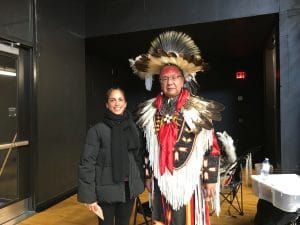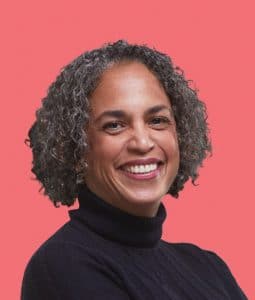- December 15, 2021
This article is part of a series on the future of architecture and design. We hope to inspire conversations about creating a better world for tomorrow, together.
Article by Gail Shillingford
Over the past decade, I have reflected on my journey on how I engage and collaborate with First Nations communities as a designer. My experience has been incredibly humbling, inspiring, challenging at times but consistently invaluable and fulfilling. As I broach my understanding of what truth and reconciliation, indigenization and decolonization, truly mean – my ultimate goal is to extend my experience into everything I do as both a designer and leader. The work we do on a daily basis can make a difference. We must begin by listening and learn by doing. Design offers us the opportunity to promote cultural awareness, education and celebrate our differences. It can be instrumental in fostering a sense of belonging, visibility and community building. Design is a way to celebrate First Nations communities, with them.
A designer’s journey
I began with unpacking my understanding of what truth and reconciliation means. Many of us have a very limited understanding of Indigenous thinking, principles and beliefs. As a design community, we have never really stopped to understand their people and culture despite the fact that they represent our country and its beginnings. I quickly came to find that the First Nations community was speaking to everything we are currently trying so desperately to achieve like inclusivity and sustainability. They consider space, place, context and history as it was, before implementing change. There is a deep respect for nature and the environment. Community is at the center of all design. Through conversation, I began decolonizing myself and my own beliefs. British and North American ways of thinking have dominated our approaches and we have regrettably overlooked the Indigenous way of doing things.
The road to repair involved applying this new way of thinking to my design approach. To me, Indigenization means re-learning and embracing what has always been, and understanding it in the context of what we have learned for the purpose and benefit of colonization. It means recognizing the validity of Indigenous worldviews, knowledge and perspectives. The term identifies opportunities for indigeneity to be expressed and incorporates Indigenous ways of knowing and doing. This notion is a fluid and evolving concept that varies with community, place and context. Like an onion, we must peel away the layers and unearth what has always been available to us in the form of wisdom from this rich community. Indigenous people are not asking us to reject colonization but simply respect there was a people and place that pre-date our European heritage. The process of decolonization can help reveal the true essence of what being Indigenous means.
“… Learning to see from one eye with the strengths of Indigenous knowledges and ways of knowing, and from the other eye with the strengths of Western knowledges and ways of knowing … and learning to use both these eyes together, for the benefit of all.” – Albert Marshall, Murdena Marshall & Cheryl Bartlett
Engaging with Indigenous communities through design

Gail Shillingford is pictured here with Chief Amos Key Jr. on Pow Wow day at the University of Toronto.
As designers, our relationship with Indigenous communities needs to continue to evolve through engagement, by learning different processes, fostering relationships and synergies, and providing common ground. Inclusivity has to be at the forefront of conversations and engagement must begin with a commitment to relationships and listening. Learn the history of place and people and understand the opportunities and constraints through their eyes and stories. The circle context is very important, as well as the ceremonial approach to speaking order, and how you participate in the conversation. I’ve learnt that you must throw out your engagement structure and let them direct and guide the conversation. You have to be ready to do the work, and truly realign your way of thinking and design, based on their feedback.
It is also paramount to demonstrate culturally relevant design. Indigenous symbolism is embedded in design and forces us to step out of our colonial design box to respond to symbolism. The orientation of the built form and the structure and layout of space may not conform to the typical North American grid pattern of development. Design alignments that we are accustomed to may need to be adjusted to respond to symbolic Indigenous orientation.
Design must foster a sense of belonging and community. It should respond to inclusion and cultivate an environment where someone who is indigenous, or anyone from an underrepresented group, feels welcomed and embraced. Visual and physical components of design can help promote a connection to space however you should also be able to visit a space and see other people who look like you. Place should make you feel connected to who you are, what you are familiar with as you see it and experience it. It is much more than just design. Its about integrating people into the conversation.
To spark real change, be committed. Volunteer, attend reconciliation events, listen and share stories
We must see this as more than a tokenized box to check. Designers need to be fully committed to going down this road, in the same way that we have with sustainability. Understanding the influential privilege that we have and recognizing that we cannot sit back in this conversation is critical. How amazing is it that we can take action through our work and engage and reconcile through design? In the context of how we move forward, a very wise chief said to me, “Just come out and get to know us.” Let’s use design to celebrate people.
How can you get started? Read Gail’s list of 16 ways to support Indigenous Peoples.
 Gail Shillingford
Gail Shillingford
With over 25 years of experience, Gail Shillingford has a strong background in urban design and landscape architecture, a combination that has allowed her to create successfully integrated and balanced built form and open space environments. As an Associate, Senior Project Director, Urban Design and Landscape Architecture at Lemay, her focus on all projects is entrenched in building community and creating attractive high-quality public realm spaces that foster socialization, inclusivity, cultural diversity, and healthy living. In each of her designs, the role of the public realm is heightened beyond creating notable destinations, to functioning as a means of bringing all people together, to revitalizing communities, incorporating sustainability and resiliency, and positioning open spaces as catalysts for social and economic vitality and viability. In addition to her experience, Gail leads Diversity, Equity, and Inclusion conversations and pursues Indigenous education and knowledge building to respond to and enable Truth and Reconciliation.